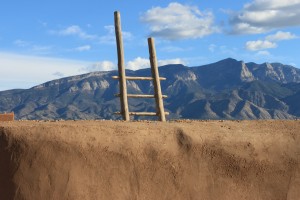 How about making this mid-year resolution: I will visit all of the State Historic Sites this summer. Few experiences can both deepen and widen your understanding of New Mexico history better than trips to the seven sites, which encompass ancestral Native life, Spanish colonists, Territorial forts, and the rip-snortin’ legend of Billy the Kid.
How about making this mid-year resolution: I will visit all of the State Historic Sites this summer. Few experiences can both deepen and widen your understanding of New Mexico history better than trips to the seven sites, which encompass ancestral Native life, Spanish colonists, Territorial forts, and the rip-snortin’ legend of Billy the Kid.
We put out the call to see what the sites are serving up this summer. Among the responses:
From August 7–9, Lincoln Historic Site participates in the annual Old Lincoln Days, with chuck-wagon cooks, blacksmiths, dancing girls, gunfighters, speakers, a parade and more. This year marks the 75th anniversary of The Last Escape of Billy the Kid, a pageant first produced in 1940 with local artist Peter Hurd as the boy bandit. Enjoy your drive through the Lincoln National Forest, with plenty of options for side trips.
 On August 9, Jemez Historic Site stages its annual Pueblo Independence Day, in conjunction with the August 10, 1680, Pueblo Revolt. The day starts with an 11-mile run from Jemez Pueblo to the site, followed by a blessing ceremony and discussions of the history and importance of the revolt. You can see Buffalo, Corn, Eagle and Shield dances throughout the day and purchase traditional arts, crafts and foods.
On August 9, Jemez Historic Site stages its annual Pueblo Independence Day, in conjunction with the August 10, 1680, Pueblo Revolt. The day starts with an 11-mile run from Jemez Pueblo to the site, followed by a blessing ceremony and discussions of the history and importance of the revolt. You can see Buffalo, Corn, Eagle and Shield dances throughout the day and purchase traditional arts, crafts and foods.
Coronado Historic Site this year celebrates its 75th anniversary with Early Native American Easel Art in New Mexico: The Dorothy Dunn Collection. Artists include Velino Shije Herrera, who in the early 1930s painted the murals in the site’s reconstructed kiva—itself a wonder to behold. Rangers have also worked with volunteers to develop traditional garden plots and expand the walking trails along the banks of the Rio Grande.
At Fort Sumner Historic Site/Bosque Redondo Memorial, you can see the oh-so-cute results of the first Navajo-Churro lambing season. The living exhibit expanded to 19 animals this spring with the birth of nine lambs, including four sets of twins, all direct descendants of the sheep brought to North America by Juan de Oñate in 1598. Navajo weavers prefer it for their world-renowned weavings. A popular saying? Diné bé liná (Sheep is Life).
That leaves Fort Stanton Historic Site, Fort Selden Historic Site, and El Camino Real Historic Trail Site. Which one will you visit first?
